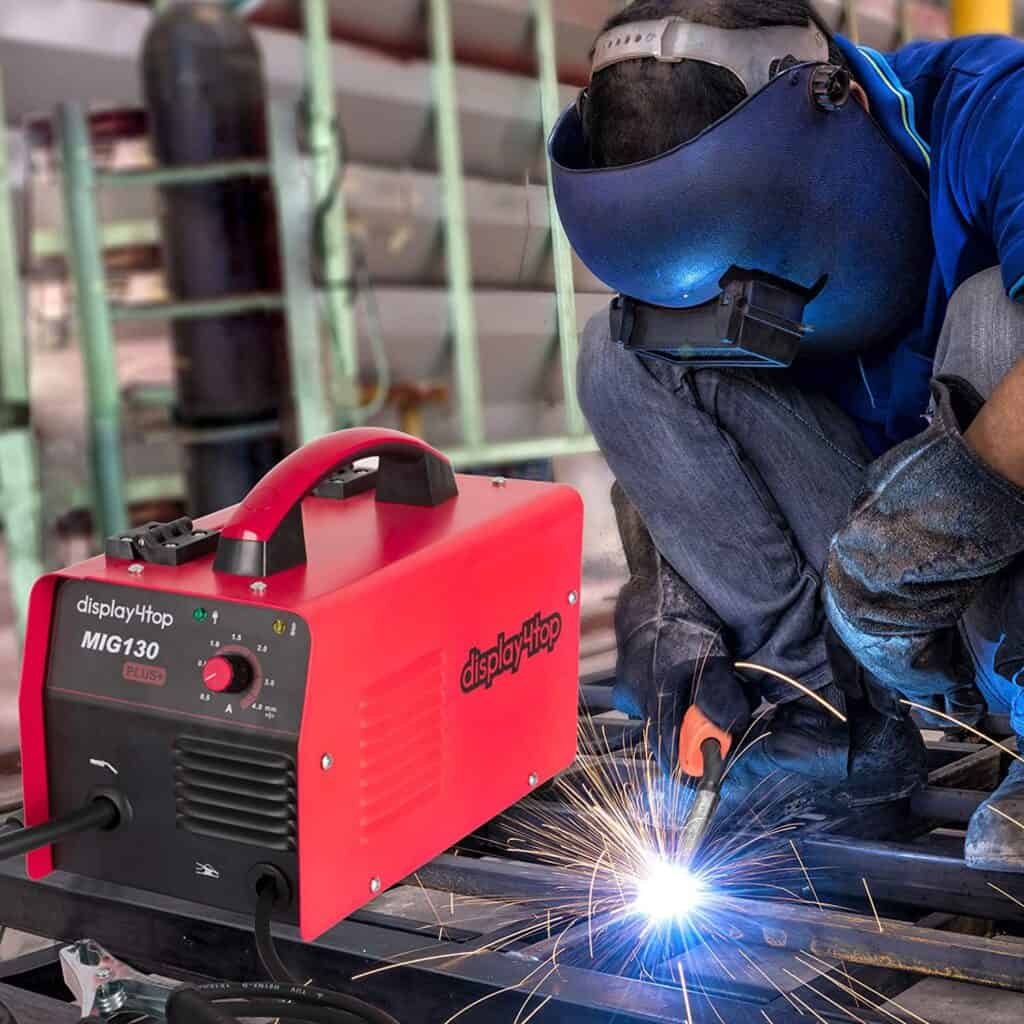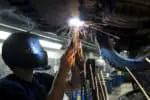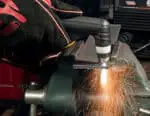It is always good practice to do the research and gather the maximum information possible, before attempting to do a welding job on your own.
 Especially, if the welding work in question is a basic one where you could do without having to call a professional. That is where a 110V welder comes in, and before we get into any further details, you should know how many amps it uses.
Especially, if the welding work in question is a basic one where you could do without having to call a professional. That is where a 110V welder comes in, and before we get into any further details, you should know how many amps it uses.
A 110V welder uses around 80 to 90 amps in a regular scenario, where you need to weld any material between light or medium gauge. But for a thicker material, it will need to use somewhere around 120 amps, which will again matter on the type of welder you will be using.
Typically, you might be more familiar with a 220V welder as opposed to a 110V welder because they have been around for a longer time and are used by most professional welders.
There was even a time when the 110V welders had a pretty negative reputation, due to reasons of not being able to perform very well.
However, that is not the case anymore and with technology improving each day, today you can get your hands on some of the best 110V welders that will give you great results.
When and who should use a 110V welder?
If you are a hobbyist like me, who prefers making your life easier and more self-sufficient without having to depend on professionals to get minor welding work done around the house or on the farm, then the 110V welder is the right choice for you.
They are perfect for welding thin materials and result in amazingly smooth welds. They can even do a fairly good job for automotive-related projects.
One of the best things about these welding machines is that they are super light and compact compared to a 220V welder. This makes it very convenient for you to carry it around to a different job location if need be.
I am assuming that if welding is more of a hobby for you, then you will not be attempting to weld any material that is thicker than 1/8”. Therefore, a 110V welder is your go-to machine without a doubt.
Advantages and disadvantages of a 110V welder
There are a few advantages and disadvantages of using a 110V welder that you should be aware of.
Advantages
1.) 110V welders are more portable due to their lighter weight compared to the 220V welders, so it is easier to get the welding job done on your own rather than having to take the help of a professional welder.
2.) They aren’t very expensive so you can save money when going for a 110V welder.
3.) With the appropriate setup you can weld different types of materials.
Disadvantages
1.) They are not the best option for industrial and heavy welding work, because their operating cycle is much lower compared to big machines.
2.) You cannot use these types of welders for heavy materials.
3.) The cheaper priced ones are not very durable compared to the heavier welders which are more expensive.
What size breaker should you use for a 110v welder?
For a 110V welder, you should normally use a circuit breaker that is at least 30 amps. This device helps prevent the welding machine from tripping out by carrying the current through it, so for a small machine like the 110V, 30 amps size breaker is appropriate.
How to pick the right 110v welder?
With various 110V welder options available for you to pick from in the market, it can become confusing and difficult the right one for your welding project. So, I have put together the ten most important factors that you should consider before buying one.
1.) You should buy a 110V welder that can be easily moved around from place to place so that you can do your welding job hassle-free. Hence, pick one that is lightweight, fun-sized, and manageable. If you have a small workspace, then a compact size with all the necessary features will be ideal.
2.) The price of any product is often an important factor to consider before buying anything. So, instead of going for the cheapest 110V welder available, go for one that is reasonably priced and doesn’t burn a hole in your pocket. It should have all the features that you will need to get the welding work done successfully.
3.) Nobody wants to get electrocuted or burnt while welding, so always consider buying a machine that has sufficient safety features, and high durability features that can prevent the machine from getting overheated. This is the best way to avoid spending more money by buying a new machine.
4.) Not all materials require the same level of heat, so it is best to buy a welder that features multi-amp settings. This gives you the freedom to control the heat level according to the material and project at hand. Plus, it is a great way to save electricity.
5.) Always check the thickness of the material that you will cut prior to buying a welding machine. Because if the machine cannot give you the desired cutting function then it will be of no use. It should at least be able to cut a depth of 1/8”, so its versatility depends on how thick it can cut.
6.) You should know that controlling the process of welding is not the easiest thing to do, especially if you are a beginner. So, the welding machine you pick should be user-friendly that make the process easy by giving you maximum control over the different levels of heat it generates.
7.) The type of welder is vital too, especially if you are a beginner. Out of Stick, MIG, and TIG welders, the MIG model is the most popularly used because it is easy to use, versatile, and is a cheaper option offering all the prominent features. Plus, it can operate faster due to its wire feeder feature.
8.) Before welding a material, it is necessary to scrutinize the effect of the process and the entire process itself. And every welder comes with processes that are different. So, always remember to check the various processes of MIG, TIG, and Stick welding.
9.) For you to use a 110V welder, you will need to confirm that your house or workspace has a 110V power outlet, otherwise, it will be quite pointless getting the machine. Although, almost every house we know comes with this power outlet by default.
10.) Check the power cycle of the welding machine, because you will need to know the maximum duration you can use it for without having to pause your work and give the machine some rest before you can use it again. This will help you determine the time taken to finish your welding project.
Are you still wondering whether buying a 110V welder be any good?
As I mentioned previously, a 110V welder will serve your purpose really well, if your welding project is a basic one that does not require any kind of professional assistance and is not a heavy-duty project. They are the ideal choice that will give you outstanding performance on materials that are small, medium, or light.
If you happen to come across a person who has had experience using it will definitely tell you one thing for sure, that this particular type of welder is super light in comparison to most others, hence easy to carry or move to a different spot when required.
You can weld both steel and iron metals with it, apart from few other types of metals. It is most commonly used for repairing a ruptured part, and also for joining metals that are not similar to one another.
In some cases, the 110V welder can also be used for fabricating ships, steel structures, automobiles, and industrial machine parts.
The fabrication process is quite simple using a 110V welder, as it constructs a secured structure by fusing the thermoplastic and metal together.
The filler materials are melted to clasp everything together and make a strong bond. Based on the type of welding you are going to do the process may vary, however, the fundamentals remain the same.
Wrapping up
I have managed to cover everything there is to know about a 110V welder in this article for your benefit before you decide to buy one for yourself.
But do check out my next article where I have given a detailed description and my personal review on some of the top 110V welders that I would recommend.
There are various brands making them these days and it can get rather overwhelming while trying to narrow it down. Happy welding!






